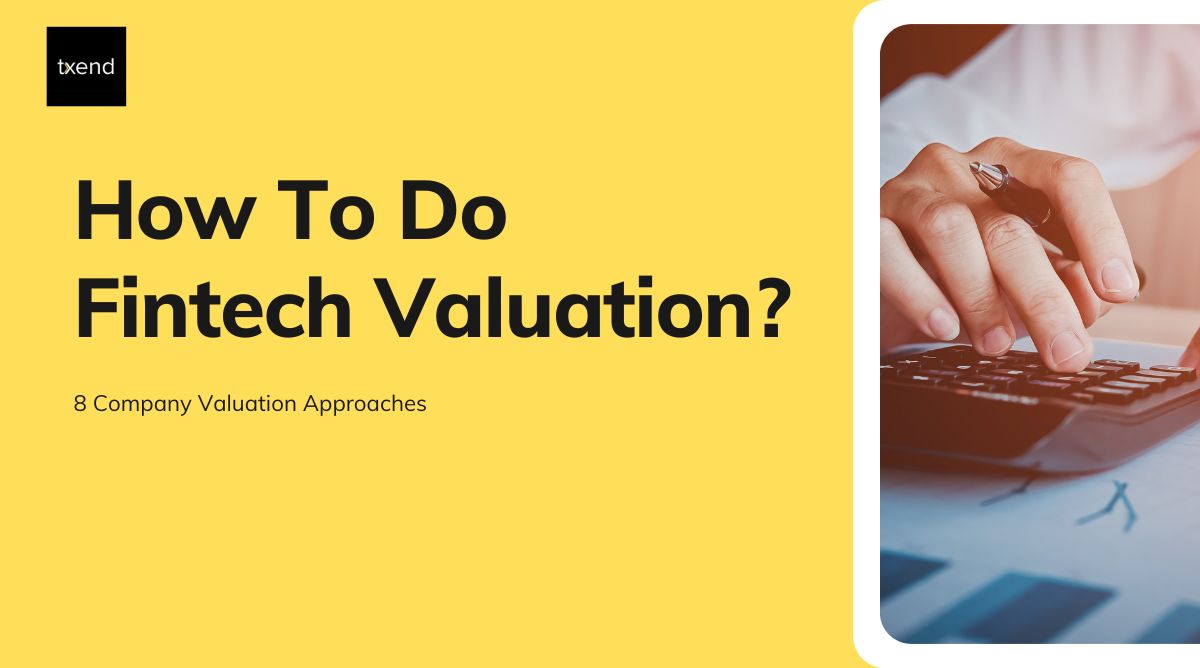In the ever-evolving financial technology landscape, one topic is paramount for investors, entrepreneurs, and enthusiasts alike: fintech valuation.
As fintech continues to reshape the financial services industry, understanding the value of fintech companies becomes pivotal.
This article embarks on a comprehensive journey through the intricacies of fintech valuation. We delve into the methodologies, metrics, and insights that drive the assessment of fintech companies’ worth.
What Is Fintech Valuation?
From the valuation of fintech companies to exploring financial technology valuation multiples and the fascinating world of AI company valuation multiples, we uncover the secrets underpinning investment decisions in this dynamic sector.
Join us as we navigate the complexities of financial technology valuation, providing a comparative analysis that sheds light on how to value fintech companies effectively.
Whether you’re an investor seeking opportunities, a fintech entrepreneur aiming to understand your company’s worth, or simply intrigued by the financial technology revolution, this article is your compass in financial technology valuation.
Key Takeaways
- Fintech startup valuation relies on growth potential, technology, and market fit, illustrated by real-life examples for better understanding.
- Financial technology valuations combine sector specifics, various multiples, and financial metrics, demystified through insights into key alchemy components.
- Company valuation in the USA involves multiple approaches like DCF, CCA, and First Chicago Method, tailored to fintech dynamics.
- Financial technology valuation components encompass user base, technology, market potential, and risk assessment, shaping the startup’s worth.
Valuing a Fintech Startup
Valuing a fintech startup is a nuanced endeavor that requires a deep understanding of both financial markets and the unique characteristics of the fintech industry.
In the USA, where the fintech landscape is vibrant and dynamic, accurate valuation is crucial for investors, founders, and stakeholders.

Here, we explore the key considerations and methods to value a fintech startup backed by illustrative examples.
Market Capitalization:
One common method is determining the fintech startup’s market capitalization. It’s calculated by multiplying the total outstanding shares by the market price per share.
For instance, if a fintech startup has 1 million shares outstanding, each trading at $10, the market capitalization is $10 million.
Discounted Cash Flow (DCF) Analysis:
DCF analysis assesses the present value of a startup’s future cash flows. You can estimate the startup’s intrinsic worth by discounting projected cash flows back to their current value.
For example, if a fintech startup expects cash flows of $1 million annually for the next five years and uses a discount rate of 10%, the DCF valuation would be around $3.86 million.
Comparable Company Analysis (CCA):
CCA involves comparing the fintech startup to similar companies in size, market, and financials. If similar fintech companies have been valued at 5 times their revenue, and the startup’s revenue is $2 million, the valuation would be $10 million.
Multiples Valuation:
Fintech valuation multiples, such as the Price-to-Earnings (P/E) ratio or Price-to-Sales (P/S) ratio, can provide quick insights.
If the average P/E ratio for fintech companies in the USA is 20, and the startup has earnings of $500,000, the valuation would be $10 million.
Stage-Based Valuation:
Early-stage fintech startups may be valued based on their development stage. For instance, a seed-stage startup might be valued at $1 million, while a Series A-stage startup could be valued at $5 million, considering its progress and potential.
User Base and Growth:
The number of users and their growth rate in the fintech industry can be significant. Investors often pay attention to metrics like Monthly Active Users (MAUs) and customer acquisition costs to gauge value.
Strategic Partnerships and Intellectual Property:
Collaborations and unique technology or patents can enhance a startup’s valuation. Investors may attribute higher value to fintech companies with strategic partnerships or valuable intellectual property.
It’s important to note that valuing fintech startups involves a mix of quantitative analysis, industry knowledge, and judgment.
Moreover, fintech startups’ valuations can evolve rapidly as they progress and secure funding rounds. Therefore, staying updated with industry trends and adjusting valuation methods is essential for accurate assessments in the ever-evolving fintech ecosystem.
The Alchemy of Fintech Valuations in the USA
The alchemy of fintech valuations in the USA combines sector-specific considerations and multiple types. Different fintech sub-sectors might emphasize particular valuation measures according to their distinct business models and growth potential.
Whether it’s payments, lending, insurance, or blockchain and crypto, Financial technology valuations depend on a delicate balance of financial and industry-specific factors, making the process as dynamic as the fintech landscape.
Alchemy of Financial technology Valuations Sector

Payments Alchemy:
- Examples: Fintech startups specializing in digital payments like Square and PayPal.
- Multiple Type: Price-to-Sales (P/S) ratio.
Valuations are often based on revenue multiples in the payments sector. For instance, if a fintech payment startup generates $10 million in annual revenue valued at $100 million, it has a P/S ratio of 10.
Lending Alchemy:
- Examples: Peer-to-peer lending platforms like LendingClub and OnDeck.
- Multiple Type: Price-to-Earnings (P/E) ratio.
Fintech lenders often focus on earnings multiples. If a lending startup earns $1 million in profits and has a valuation of $20 million, its P/E ratio is 20.
Insurtech Alchemy:
- Examples: Fintech companies revolutionizing the insurance industry, like Lemonade and Root.
- Multiple Type: Customer Lifetime Value (CLTV) multiples.
Insurtech startups may prioritize CLTV, which measures the expected value of a customer over their lifetime. For instance, if an insurtech startup’s CLTV multiple is 3x, and the average customer’s lifetime value is $1,000, the startup’s valuation would be $3,000 per customer.
Blockchain and Crypto Alchemy:
- Examples: Cryptocurrency exchanges such as Coinbase and blockchain solution providers like Chain.
- Multiple Type: Network Value-to-Transactions (NVT) ratio.
In the blockchain and crypto sector, NVT is a key metric. It compares the network’s market value to the transaction volume. If a blockchain startup’s NVT is 50, and its annual transaction volume is $10 million, its valuation would be $500 million.
Multiple Types with Examples
Price-to-Earnings (P/E) Ratio:
Example: A fintech lending startup with $5 million in earnings and a valuation of $50 million has a P/E ratio of 10.
Price-to-Sales (P/S) Ratio:
Example: A fintech payment company with $20 million in annual revenue and a valuation of $200 million has a P/S ratio of 10.
Customer Lifetime Value (CLTV) Multiples:
Example: An insurtech startup with an average CLTV of $1,500 per customer and a CLTV multiple of 4x would be valued at $6,000 per customer.
Network Value-to-Transactions (NVT) Ratio:
Example: A blockchain startup with a $1 billion market value and an annual transaction volume of $100 million would have an NVT ratio of 10.
8 Company Valuation Approaches
Valuing fintech companies in the USA involves employing various approaches that provide insights into their worth.

Here are the key company valuation approaches used:
Market Capitalization (Market Cap):
Market capitalization is the simplest valuation approach, calculated by multiplying a fintech company’s stock price by the total number of outstanding shares. It reflects the company’s value as perceived by the public markets.
- Applicability: Ideal for publicly traded fintech firms like PayPal and Square.
Comparable Company Analysis (CCA):
CCA involves comparing a fintech firm to similar publicly traded companies in terms of size, business model, and financial metrics. The valuation is based on the average valuation multiples of the comparable companies.
- Applicability: Suitable for both public and private fintech companies by using data from publicly traded peers.
Discounted Cash Flow (DCF) Analysis:
DCF estimates the present value of a fintech company’s future cash flows. It considers revenue, expenses, and growth rates. This approach provides an intrinsic valuation based on expected cash flows.
- Applicability: Suitable for private fintech startups and established firms with predictable cash flows.
Earnings Multiples:
Earnings multiples like Price-to-Earnings (P/E) and Price-to-Sales (P/S) ratios compare a fintech firm’s earnings or revenue to its valuation. They are often used for relative valuation.
- Applicability: Applicable to both public and private fintech companies for relative comparisons.
Asset Valuation:
Asset-based valuation focuses on the tangible and intangible assets a fintech company possesses. It includes the value of patents, technology, intellectual property, and physical assets.
- Applicability: Relevant for fintech firms with significant assets, such as those involved in hardware or intellectual property.
Growth Rates and Future Potential:
Valuation can be influenced by the fintech company’s growth rates and future potential. Companies with rapid growth and disruptive technologies often command higher valuations.
- Applicability: Relevant for innovative fintech startups with promising growth prospects.
AI and Data-Driven Valuation:
With AI and data analytics advancements, fintech firms are using data-driven models to predict future valuations. Machine learning algorithms assess multiple data inputs to generate forecasts.
- Applicability: Emerging as a supplementary approach for tech-savvy fintech firms.
Industry-Specific Metrics:
Some fintech sectors may have unique metrics for valuation. For example, insurtech companies may use Customer Lifetime Value (CLTV) multiples.
- Applicability: Specific to fintech sub-sectors with distinct valuation criteria.
In the dynamic fintech landscape of the USA, valuation approaches can vary widely based on the company’s stage, business model, and industry.
Financial technology valuations are influenced by factors like market sentiment, regulatory environment, and technological advancements, making it crucial for stakeholders to use a combination of approaches to understand a fintech firm’s value comprehensively.
Components of Fintech Valuation in the USA
Valuing fintech companies in the USA involves assessing various components that reflect their financial health, growth potential, and market positioning. Here are the key components of Financial technology valuation:
Revenue and Income Streams:
Fintech valuation starts with thoroughly analyzing the company’s revenue streams, including transaction fees, subscription services, and licensing fees. Income from sources like interest on loans or investments is also considered.
- Significance: Revenue and income streams are fundamental indicators of a fintech company’s financial performance.
User Base and Market Share:
The size and growth rate of a fintech company’s user base, along with its market share, play a crucial role in valuation. A larger and rapidly expanding user base can indicate strong market demand and growth potential.
- Significance: User metrics provide insights into a company’s competitive positioning and scalability.
Technology and Intellectual Property:
Fintech firms often rely on innovative technology and intellectual property (IP) such as patents, algorithms, and software. The value of these assets is assessed in the valuation process.
- Significance: Technology and IP contribute to a company’s competitive advantage and can impact its valuation positively.
Growth Rate and Projections:
Financial technology valuations consider the company’s historical growth rates and future growth projections. High growth potential can result in a higher valuation.
- Significance: Growth is a crucial driver of Financial technology valuations, as investors seek companies with the potential for significant expansion.
Financial Ratios and Multiples:
Financial technology valuation often involves analyzing financial ratios and multiples such as Price-to-Earnings (P/E), Price-to-Sales (P/S), and Price-to-Book (P/B) ratios. These metrics provide insights into relative valuation.
- Significance: Financial ratios help compare the company’s valuation to industry peers.
Market Trends and Competitive Landscape:
Financial technology valuations consider market trends, regulatory changes, and the competitive landscape. Understanding how a company positions itself in a dynamic industry is essential.
- Significance: Market dynamics can impact a company’s growth potential and risk, affecting its valuation.
Risk Assessment:
Fintech valuations include an assessment of risks associated with the company’s operations, regulatory environment, and market conditions. Higher perceived risks may lead to lower valuations.
- Significance: Risk assessment helps investors and stakeholders gauge the potential downside of an investment.
Exit Strategy and Market Demand:
Valuation considers the company’s exit strategy, whether through acquisition, initial public offering (IPO), or other means. The demand for fintech firms in the exit market influences their valuation.
- Significance: The ability to realize the valuation through an exit strategy is critical for investors.
Customer Retention and Lifetime Value:
Financial technology valuations assess customer retention rates and Customer Lifetime Value (CLTV). High retention and CLTV indicate strong customer relationships and revenue sustainability.
- Significance: Customer metrics indicate a fintech company’s ability to generate recurring revenue.
Regulatory Compliance and Legal Factors:
Fintech valuations consider the company’s compliance with financial regulations and legal factors that may impact its operations. Non-compliance can pose risks to valuation.
- Significance: Regulatory issues can affect a company’s growth and operational capabilities.
Financial technology valuation in the USA is a comprehensive process considering quantitative and qualitative factors. Investors, analysts, and stakeholders use these components to assess a fintech company’s value and make informed decisions regarding investment or acquisition.
Frequently Asked Question
Unlike traditional valuations focused on historical financials and stability, Financial technology valuation considers unique growth prospects and technology-driven aspects.
Financial technology valuation multiples gauge company’s worth based on financial metrics like revenue, users, or transactions, aiding comparative analysis.
Factors affecting Financial technology valuation include user growth, competitive landscape, regulatory changes; assessing their influence aids accurate valuation.
Fintech and AI companies often employ Discounted Cash Flow (DCF), Comparable Company Analysis (CCA), or First Chicago Method for valuation.
Conclusion: Fintech Valuation Unveiled
In conclusion, the world of fintech valuation is a dynamic landscape where understanding the valuation of fintech companies, how to value fintech companies, fintech valuation multiples, and AI company valuation multiples is essential.
This comparative analysis underscores the multifaceted nature of fintech valuation. As fintech continues to reshape the financial industry, accurate valuation remains paramount for investors, entrepreneurs, and stakeholders navigating this evolving sector. The insights gained from this analysis can guide decisions and strategies in the ever-expanding realm of fintech.



